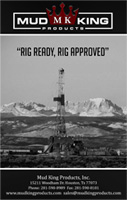Rubber vs. Urethane Pistons: Understanding the Differences
You know how critical pistons are in mud pumps. They keep drilling mud moving under high pressure, making them one of the most important mud pump expendables you’ll ever work with. The challenge is knowing which piston type works best for your rig. That’s why we’re breaking down Urethane vs Rubber and replaceable vs bonded; so you can compare, understand the differences, and choose the right fit for your drilling conditions. Each option is designed for tough environments, but each excels under different circumstances.
What Are Replaceable Rubber Pistons?
Replaceable rubber pistons are designed with a fabric heel and replaceable nitrile rubber head that mounts onto a reusable hub. They are not bonded, which means when the rubber wears down, you can replace it without changing the hub—as long as the hub itself hasn’t worn past the indicator mark. This makes them one of the most cost-effective piston options. Replaceable rubber pistons are widely used across land and offshore rigs because they balance reliability with budget control.
The benefits of rubber pistons include:
- Strong, reliable sealing under pressure
- Economical option with replaceable rubber heads
- Proven performance in land and offshore rigs
- Effective in a wide range of mud types
- Easy replacement that minimizes downtime
What Are Rubber Bonded Pistons?
Rubber bonded pistons take performance a step further. Made of carboxylated nitrile rubber, they create one of the best seals available. This makes them especially useful in worn liners, where they help extend liner life and prevent costly leaks. Rubber bonded pistons are a smart choice when you need to squeeze extra life out of your equipment without sacrificing reliability.
The benefits of rubber bonded pistons include:
- Superior sealing compared to other designs
- Extends life of worn liners
- Reduces risk of mud leakage
What Are Urethane Pistons?
Urethane pistons are built for strength and extended service life when used under the right conditions. The urethane-bonded design makes it especially effective in lower temperature ranges, often paired with ceramic liners for maximum efficiency. Known for their toughness, urethane bonded pistons also perform well in high-pressure.
The benefits of urethane pistons include:
- Long service life under the right drilling conditions
- Excellent performance with ceramic liners
- Durable under high pressure
- Consistent reliability in oil-based mud systems
- Reduced downtime with fewer replacements
Rubber vs. Urethane Pistons: Make the Right Call
Both rubber and urethane pistons are engineered for high performance in drilling mud systems, but the right choice depends on your specific rig conditions. Rubber pistons are flexible, economical, and proven across many applications. Urethane pistons are built for durability in high-pressure applications, especially when paired with ceramic liners.
As oilfield equipment suppliers in Houston, we know every drilling operation has unique needs. Matching your piston type to your environment (temperature, mud type, and service expectations) ensures that your mud pumps stay efficient and dependable.
Do you need pistons that keep your operation running smoothly and safely? Contact us today to get a quote on high-performance mud pump expendables designed for your rig. If drilling in high-pressure, extreme conditions, ask us about our best-performing piston, the Cowboy XT Piston.


